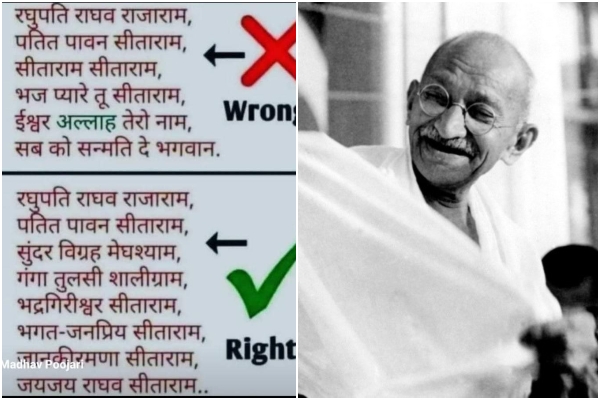Gandhi modified Ram dhun to appease Muslims; Will Congress adopt original to appease Hindus today?
The bhajan was first used by Gandhi during his 241 miles march to Dandi during the Dandi March in 1930 to oppose a new law that the British enacted to restrict Indians from producing or selling salt.
Total Views |
We all have fondly till date sung the Ram bhajan 'Raghupati Raghav Raja Ram' which was once a common hymn sung at the Gandhi prayer meetings. It is to note that the Congress party had changed the lyrics of the Bhajan adding the words Allah, Karim in order to appease the Muslim vote bank back then
One of the twitter users happened to share a image with Ramsevak Madhav Poojari's name tag reading, "the Congress amended a hindu prayer to appease 'their' votebank". The original lyrics of the bhajan had no words like Allah, Rahim and Karim and had been replaced in wake of the elections.

2 October 2021 marks the 152nd birth anniversary of Mahatma Gandhi, also known in India as the ‘Father of the Nation. Born into a Gujarati Hindu Modh Bania family in the coastal town of Porbandar, Gandhi completed his education from England and from there went to South Africa to practice law. He later returned to India and joined the country’s independence struggle against the oppressive British rule. Among other things, he experimented with the organisation of daily prayer meetings aimed at achieving reconciliation between different communities, most notably Hindus and Muslims. During these meetings, Gandhi encouraged community singing of popular bhajans and religious hymns and discussed at length their lyrics and content.
The bhajan was first used by Gandhi during his 241 miles march to Dandi during the Dandi March in 1930 to oppose a new law that the British enacted to restrict Indians from producing or selling salt. It was during this movement that Gandhi popularised the use of “Raghupati Raghav Raja Ram” as the marchers sang to keep their spirits up.
Gandhi was not the creator of the hymn. The lyrics were taken from Shri Nama Ramayanan, an old religious text penned by Sri Lakshmanacharya, and modified by Gandhi. The original lines went:
Raghupati raghava rajaram,
patita paavana sitaram.
Sundara vigraha meghashyam,
Ganga tulasi salagram.
Bhadra girishwara sitaram,
Bhagat janapriya sitaram.
Janaki ramana sitaram,
Jaya jaya raghava sitaram
Gandhiji’s version, which he and his fellow satyagrahis chanted during the Dandi March of 1930 runs:
Raghupati raghava rajaram,
Patita paavana sitaram,
bhaj pyaare tu sitaram
ishwar allah tero naam,
sabko sanmati de bhagwan.
Modified with a view to spreading the message of 'reconciliation between Hindus and Muslims', the song was set to tune by the renowned musicologist, Vishnu Digambar Paluskar. Ahead of the UP elections, Priyanaka Gandhi Vadra was seen visiting famous Hindu temples in Saharanpur and Prayagraj, dropping hints that she would follow soft Hindutva to counter the BJP in the UP polls. Striving hard to remain politically relevant in Uttar Pradesh, the Congress has decided to adopt a multi-pronged strategy to revive itself in the state, which includes a 12,000-kilometre-long Pratigyan Yatra, ghar wapsi of the old guards and soft Hindutva.
One of the senior Congress leader had also said that the party would 'stick' to its soft Hindutva policy in the state. Now, as the Congress party faces the downturns in reference to the politics in India, it will be interesting to see if the party adopts the original lyrics to appease the Hindu voters today.
.
.
